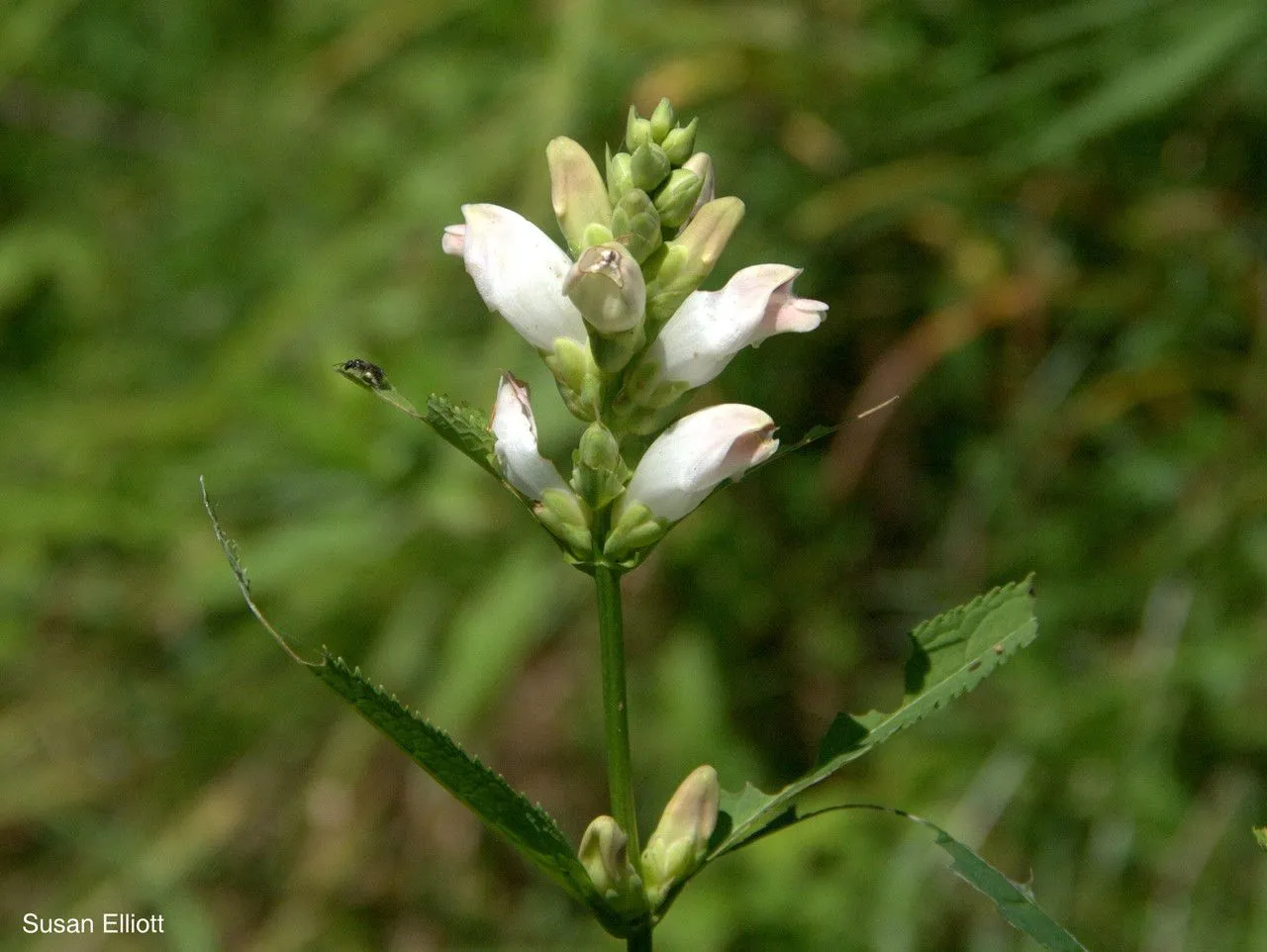
Author: L.
Bibliography: Sp. Pl.: 611 (1753)
Year: 1753
Status: accepted
Rank: species
Genus: Chelone
Vegetable: False
Observations: C. & E. Canada to NC. & E. U.S.A.
Balmony, scientifically known as Chelone glabra, is a perennial herb belonging to the Plantaginaceae family. It is indigenous to a range extending across central and eastern regions of Canada and the United States, from North Carolina to the northern and eastern parts of the country.
This hardy plant typically thrives in wetlands, including marshes, swamps, and along the edges of streams and ponds. It favors moist, acidic soils and partial to full sunlight. Its preference for such environments is a testament to its adaptability and resilience in challenging habitats.
Balmony features striking, tubular flowers that bloom from mid-summer to early fall. These blossoms are characteristically white or occasionally tinged with pink, with a shape reminiscent of a turtle’s head, which is why the plant is also sometimes referred to as “Turtlehead.” This unique floral structure not only adds a distinct aesthetic to the landscapes it adorns but also plays a crucial role in the plant’s reproductive process, facilitating pollination primarily by bumblebees and other long-tongued insects.
The foliage of Chelone glabra is equally noteworthy, with dark green, lance-shaped leaves that have serrated edges, creating a dense and lush appearance. These leaves are arranged oppositely along the stem and provide a rich, textured backdrop to the delicate blooms.
Chelone glabra has also been used in traditional herbal medicine. Native American communities and early settlers valued it for its purported health benefits, often employing it as a remedy for digestive issues and as a mild laxative. Modern herbalists continue to explore its potential applications, though it is primarily appreciated for its ornamental value in contemporary gardening.
Given its ecological preferences and distinct characteristics, Balmony serves as both an important component of wetland ecosystems and a charming addition to garden settings that seek to emulate or incorporate naturalistic designs. Its role in supporting pollinators further underscores its environmental value, contributing to the biodiversity and health of its native habitats.
Eng: balmony, snakehead, turtlehead, white turtlehead, smooth balmony
Dan: skjoldblomst
Nno: snauskjoldblom
Nob: snauskjoldblom
Swe: vit sköldpaddsört
Fra: galane glabre
En: Balmony, Turtlehead, Snakehead, White turtlehead, Smooth balmony
Zh: 龟头花
Da: Skjoldblomst
Fr: Galane glabre
Nb: Snauskjoldblom
Nn: Snauskjoldblom
Sv: Vit sköldpaddsört
Zh-tw: 龜頭花
© copyright of the Board of Trustees of the Royal Botanic Gardens, Kew.
© copyright of the Board of Trustees of the Royal Botanic Gardens, Kew.
Taken Aug 15, 2021 by diane diane gagnon (cc-by-sa)
Taken May 17, 2012 by EOL − Charlie Hohn (cc-by-nc)
Taken Sep 17, 2019 by Leia Prebinski (cc-by-sa)
Taken Aug 19, 2021 by Pascal Guerin (cc-by-sa)
Taken Aug 14, 2022 by Cynthia Spaulding (cc-by-sa)
Taken Aug 17, 2021 by rejeane ouellet (cc-by-sa)
Taken Aug 21, 2021 by Sylvie Sylvie Bourrelly (cc-by-sa)
Taken Aug 19, 2021 by Louis-David Malo (cc-by-sa)
Taken Aug 19, 2021 by Perry Falconer (cc-by-sa)
Taken Aug 11, 2021 by Eileen FitzGerald (cc-by-sa)
Taken Jul 26, 2015 by EOL − Marv Elliott (cc-by-nc)
Taken Jul 19, 2015 by EOL − Dave Behm (cc-by-nc)
Taken Jul 25, 2015 by EOL − Susan Elliott (cc-by-nc)
Taken Aug 12, 2022 by manuseitz (cc-by-sa)
Taken Sep 23, 2021 by max (cc-by-sa)
Taken Mar 2, 2015 by EOL − srall (cc-by-nc)
Growth habit: Forb/herb
Family: Myrtaceae Author: (F.Muell.) K.D.Hill & L.A.S.Johnson Bibliography: Telopea 6: 402 (1995) Year: 1995 Status:…
Family: Rubiaceae Author: Pierre ex A.Froehner Bibliography: Notizbl. Bot. Gart. Berlin-Dahlem 1: 237 (1897) Year:…
Family: Sapindaceae Author: Koidz. Bibliography: J. Coll. Sci. Imp. Univ. Tokyo 32(1): 38 (1911) Year:…
Family: Asteraceae Author: A.Gray Bibliography: Pacif. Railr. Rep.: 107 (1857) Year: 1857 Status: accepted Rank:…
Family: Fabaceae Author: Medik. Bibliography: Vorles. Churpfälz. Phys.-Ökon. Ges. 2: 398 (1787) Year: 1787 Status:…
Family: Aspleniaceae Author: (Cav.) Alston Bibliography: Bull. Misc. Inform. Kew 1932: 309 (1932) Year: 1932…